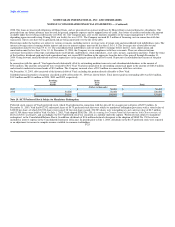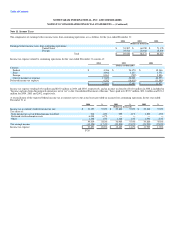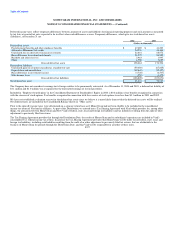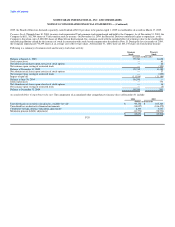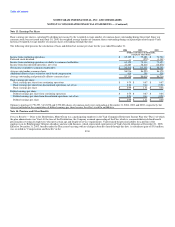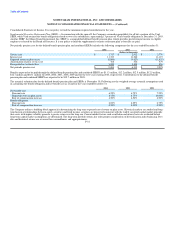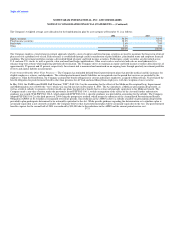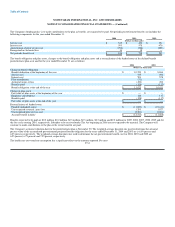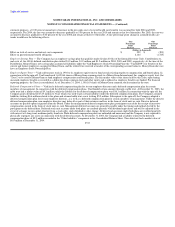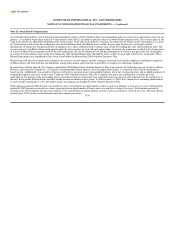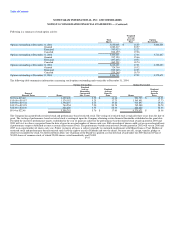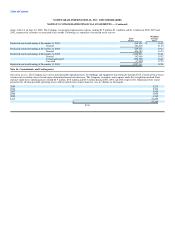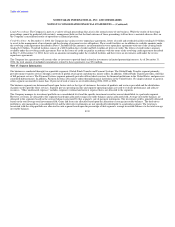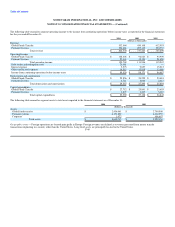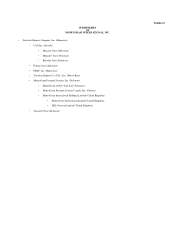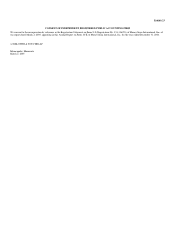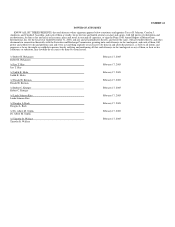MoneyGram 2004 Annual Report Download - page 79
Download and view the complete annual report
Please find page 79 of the 2004 MoneyGram annual report below. You can navigate through the pages in the report by either clicking on the pages listed below, or by using the keyword search tool below to find specific information within the annual report.
Table of Contents
MONEYGRAM INTERNATIONAL, INC. AND SUBSIDIARIES
NOTES TO CONSOLIDATED FINANCIAL STATEMENTS — (Continued)
surement purposes, a 10.00 percent annual rate of increase in the per capita cost of covered health care benefits was assumed for both 2004 and 2003,
respectively. For 2004, the rate was assumed to decrease gradually to 5.00 percent by the year 2010 and remain at that level thereafter. For 2003, the rate was
assumed to decrease gradually to 5.00 percent by the year 2008 and remain at that level thereafter. A one-percentage point change in assumed health care
trends would have the following effects:
One One
Percentage Percentage
Point Point
Increase Decrease
(Dollars in thousands)
Effect on total of service and interest cost components $ 259 $ (209)
Effect on postretirement benefit obligation 2,144 (1,745)
Employee Savings Plan — The Company has an employee savings plan that qualifies under Section 401(k) of the Internal Revenue Code. Contributions to,
and costs of, the 401(k) defined contribution plan totaled $1.9 million, $1.2 million and $1.2 million in 2004, 2003 and 2002, respectively. At the time of the
Distribution, MoneyGram's new savings plan assumed all liabilities under the Viad Employees Stock Ownership Plan (the "Viad ESOP") for benefits of the
current and former employees assigned to MoneyGram, and the related trust received a transfer of the corresponding account balances. MoneyGram does not
have an Employee Stock Ownership Plan.
Employee Equity Trust — Viad sold treasury stock in 1992 to its employee equity trust to fund certain existing employee compensation and benefit plans. In
connection with the spin-off, Viad transferred 1,632,964 shares of MoneyGram common stock to a MoneyGram International, Inc. employee equity trust (the
"Trust") to be used by MoneyGram to fund employee compensation and benefit plans. The fair market value of the shares held by this Trust, representing
unearned employee benefits is recorded as a deduction from common stock and other equity and is reduced as employee benefits are funded. For financial
reporting purposes, the Trust is consolidated. As of December 31, 2004, 1,390,163 shares of MoneyGram common stock remained in the trust.
Deferred Compensation Plans — Viad had a deferred compensation plan for its non-employee directors and a deferred compensation plan for certain
members of management. In connection with the deferred compensation plans, Viad funded certain amounts through a rabbi trust. At December 31, 2003, the
rabbi trust had a market value of $9.1 million, while the liability for the deferred compensation plans was $16.1 million. In connection with the spin-off, the
Company paid a dividend of $7.25 million to Viad, which was used to pay certain liabilities under the deferred compensation plans. The Company assumed
liabilities totaling $6.6 million related to the plans and retained rabbi trust assets totaling $5.5 million. Subsequent to the spin-off, the Company adopted a
deferred compensation plan for its non-employee directors, as a well as a deferred compensation plan for certain members of management. Under the director
deferred compensation plan, non-employee directors may defer all or part of their retainers and fees in the form of stock units or cash. Director deferred
accounts are payable upon resignation from the Board. Under the management deferred compensation plan, participants may defer the receipt of incentive
compensation awards in the form of stock units or cash. Management deferred accounts are generally payable under the timing and method elected by the
participant on the deferral date. Deferred stock unit accounts under both plans are credited quarterly with dividend equivalents and will be adjusted in the
event of a change in our capital structure from a stock split, stock dividend or other change. Deferred cash accounts under both plans are credited quarterly
with interest at a long-term, medium-quality bond rate. Both deferred compensation plans are unfunded and unsecured and the Company is not required to
physically segregate any assets in connection with the deferred accounts. At December 31, 2004, the Company had a liability related to the deferred
compensation plans of $5.9 million recorded in the "Other liabilities" component in the Consolidated Balance Sheet. The rabbi trust had a market value of
$6.0 million at December 31, 2004. F-35


